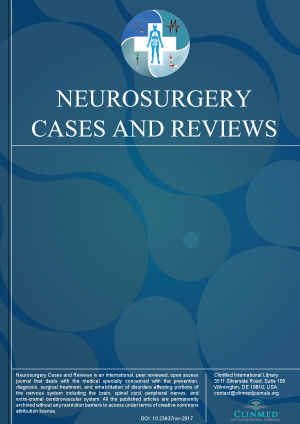Open Access DOI:10.23937/ncr-2017/1710009
Lymphomatoid Granulomatosis of the Central Nervous System, Successfully Treated with Corticosteroid Alone: A Case Report and Review of the Literature
Alexandra Benouaich-Amiel, Shlomit Yust-Katz, Suzana Fichman and Tali Siegal
Article Type: Case Report | First Published: December 20, 2018
Lymphomatoid granulomatosis (LYG) is a rare, Epstein barr virus (EBV) associated, angiocentric B cell proliferation, which usually involves the lung but may also involve, more rarely, the central nervous system. Its malignant potential is uncertain, and seems to be linked to the number of EBV positive B cells. We report the case of a 32-years-old patient, with an antecedent of LYG grade 2, involving lung, who presented with a brain mass lesion one year later, which appears to be a grade 1 LYG wi...
Open Access DOI:10.23937/ncr-2017/1710008
Multimodal MRI of Extracranial Glioblastoma Dissemination
Alice Venier, Luca Roccatagliata, Alessandro Cianfoni and Emanuele Pravata
Article Type: Case Report | First Published: December 15, 2018
Glioblastoma scalp dissemination is uncommon. Infiltration may occur through the craniotomy, suggesting diffusion from the surgical site as the most likely mechanism. At Magnetic Resonance Imaging (MRI), features of the metastatic tissue resemble those of the primary tumor. We show multimodal MRI appearance of a glioblastoma disseminating to the scalp. The patient presented with a stiff, non-tender palpable mass within the extracranial soft tissues, five months after surgery. Distinctive finding...
Open Access DOI:10.23937/ncr-2017/1710007
Giant Prolactinoma and Concomitant Internal Carotid Artery Pseudo-Aneurysm: All Stages of the Decision-Making Process
A Giorgianni, P Veiceschi, G Agresta, S Balbi and D Locatelli
Article Type: Case Report | First Published: November 19, 2018
We report a case of right internal carotid artery pseudo-aneurysm, arising in the aspects of a giant macroadenoma in a 57-years-old man, presented with right severe temporal orbital headache and vomiting. Computed tomography scan (CT) revealed a destructive skull base mass extended from sellar region to clivus. Pre and post-gadolinium brain magnetic resonance (MRI) confirmed the lesion, characterized by an encasement of optic nerves and carotid siphons bilaterally, with a pseudo-aneurysm of cave...
Open Access DOI:10.23937/ncr-2017/1710006
Surgical Treatment of Mesial Temporal Lobe Epilepsy: Selective Amygdalohippocampectomy Using Niemeyer's Approach
Adriana Rodrigues Liborio dos Santos, Gabriel Mufarrej, Priscila Oliveira da Conceicao, Paulo Luiz da Costa Cruz, Daniel Dutra Cavalcanti, Leila Chimelli and Paulo Niemeyer Filho
Article Type: Original Article | First Published: November 19, 2018
Selective Amygdalohippocampectomy (SAH) is a widespread technique for Mesial Temporal Lobe Epilepsy (MTLE) treatment. Dr. Niemeyer was the first to describe SAH using transventricular approach technique in 1958. In 2018, we celebrate 60 years of the original description of Niemeyer's approach. This study reviews the approach in light of currently technology and shows the results achieved with patients submitted to SAH following Niemeyer's approach at Instituto Estadual do Cérebro Paulo Niemeyer...
Open Access DOI:10.23937/ncr-2017/1710005
Frazier Suction Cannula Fluid Control Technical Note
Manuel Dujovny, Channan Kositzke, Pablo Sosa and Fabian Cremaschi
Article Type: Research Article | First Published: November 10, 2018
Suction capability in neurosurgery is a critical tool utilized to clear the field and improve visualization of anatomical structures. It is also used for fragmentation and debulking of pathological tumor masses. Prior to the Frazier cannula, there was no orifice bent pressure relief valve associated with suction; this tool provides independent dual suction force. The Frazier cannula has the capability to reach absolute suction or zero suction instantaneously. In this article, we introduce a new ...
Open Access DOI:10.23937/ncr-2017/1710003
What Should Guide Decision-Making Process in Urgency? A Curious Case of Right Acute Hemiparesis
Francesco Restelli, Gianluca Agresta, Tommaso Alfiero, Alessandro Dario and Davide Locatelli
Article Type: Case Report | First Published: October 31, 2018
As physicians and neurosurgeons, our daily practice in Emergency Departments sometimes calls us to manage patients and to take decisions in sub-optimal conditions, maybe with partial anamnesis, incomplete neurological examinations or with lacks in routine radiological and laboratory exams. Such eventuality, although it may sometimes lead to misdiagnose and to confound some pathological conditions, fortunately is not always linked to bad repercussions for patients. This is especially true when de...
Open Access DOI:10.23937/ncr-2017/1710002
A Giant Cell Granuloma of the Temporal Bone: A Case Report
Giyas Ayberk, Selen Isık Adiloglu, Aylin Kılıc Yazgan, Mahmut Ferhat and Mehmet Faik Ozveren
Article Type: Case Report | First Published: June 15, 2018
A giant cell granuloma (GCG) rarely occurs in the skull bones. Although it has destructive character, the GCG is used as the synonym of giant cell reparative granuloma (GCRG) in the literature. Differentiation from other osteolytic lesions quite difficult. The first case of GCG in the temporal bone was reported by Hirschl and Katz in 1974. Even though the GCG is not a true neoplasm, the locally aggressive behavior of this tumor necessitates surgical excision whenever possible....
Open Access DOI:10.23937/ncr-2017/1710001
Primary Central Nervous System Lymphoma: A Differential of Midline Crossing Lesions
Renu Pokharna, Miles W Reese, Souvik Sen and Tushar Trivedi
Article Type: Case Report | First Published: January 11, 2018
Primary Central Nervous System Lymphoma (PCNSL) is a rare non-Hodgkin type neoplasm, which crosses the midline. We report an unusual case of a 71-year-old Caucasian female who was shown to have PCNSL by a tissue biopsy after the brain Magnetic Resonance Imaging (MRI) showed Central Nervous System (CNS) lesions crossing the corpus callosum....

